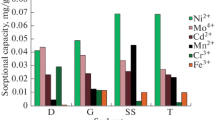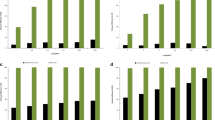Abstract
Metals which form soluble stable ammine complex cations were extracted by lignite and brown coal by adsorption from ammoniacal solutions of the metal sulfates and carbonates. Known dry weights of the coal were contacted with the solution by agitation in closed polyethylene containers and then separated by filtration. The amount of metals adsorbed was determined from analysis of the solutions before and after contacting. It was found that metal loadings increase with increases in contact time, liquid to solid ratio and with metal concentration at short contact times, but loadings decrease with increases in coal particle size, ammonium ion concentration and with metal concentration at long contact times. Loading is affected only slightly by temperature and excess ammonia. In single contacting high loading is associated with low percentage extraction, and vice-versa, but relatively high values for both loading and extraction were obtained by counter-current contacting. The highest loadings obtained with single contacts, by using favorable combinations of conditions, were 22 pct copper, 15 pct nickel, 17 pct zinc, 31 pct cadmium, 37 pct silver and 13 pct cobalt. Comparative experiments were done with coals from Australia, United States of America, and West Germany. More development of the method is required before meaningful comparison could be made with other hydrometallurgical methods. It is speculated that possible applications could include treatment of ammoniacal solutions derived from sulfide, carbonate and oxide ores, pressure leaching of sulfides, preferential leaching of scrap metal,in situ solution mining and processing of oceanfloor nodules, arid effluent solutions which already contain ammonia.
Similar content being viewed by others
References
T. Sasaki: Science Department Research Report, Kyushu University, 1947, vol. 1, pp. 23-31.
1. V. Gelbev and K. K. Stramkovskava:Iz. Vost. Filialov Akad. Nauk. SSSR, 1957, no. 12, pp. 78’2
L. Baetsle:Proc. Scientific Conference Monaco, 1959, vol. l,pp. 182–212.
M. L. Martins:Rev. Port. Quim., 1961, vol. 3, no. 1, pp. 3–8.
J. O'Keefe: Report No. TM 138, p. 8, Australian Atomic Energy Commission, Lucas Heights, New South Wales, 1962.
M. W. Wilding and D. W. Rhodes: Report No. IDO 14624, p. 58, United States Atomic Energy Commission, 1963.
K. Wesolowski and M. Ryczek: British Patent 1,002,413,1965.
1. S. Sofiev:Uzb. Khim. Zh., 1966, vol. 10, no. 5, pp. 58–61.
H. L. Ong and V. E. Swanson:Econ. Geol, 1966, vol. 61, no. 7, pp. 1214–31.
V. A. Altekar, M. J. Shahani, and A. K. Saha:Fuel, 1974, vol. 53, no. 1, pp. 29–31.
A. K. Saha, M. J. Shahani, and V. A. Altekar:Hydrometallurgy, 1977, vol. 2, no. 3, pp. 285–92.
N. G: Siviour, G. M. Pearson, G. V. Cullen, and H. W. Worner: Australian Patent 450,549,1971. (Corresponding patents granted in 16 other countries).
A Anon:J. Metals, 1972, vol. 24, no. 3, p. 14.
H. Herman:Brown Coal, pp. 4–7, State Electricity Commission of Victoria, Melbourne, 1952.
M. R. McKeown:Coal in Australia, p. 660, Australasian Institute of Mining and Metallurgy, Melbourne, 1953. $
Author information
Authors and Affiliations
Additional information
G. V. CULLEN formerly Manager, Institute of Materials Research, Department of Metallurgy, University of Melbourne, Parkville, Victoria, 3052, Australia.
N. G. SIVIOUR formerly Senior Research Officer, Institute of Materials Re- search, Department of Metallurgy University of Melbourne.
G. M. PEARSON formerly Experimental Officer, Institute of Materials Research, Department of Metallurgy, University of Melbourne.
Rights and permissions
About this article
Cite this article
Cullen, G.V., Siviour, N.G. & Pearson, G.M. Extracting metals from ammoniacal solution with low rank coals. Metall Trans B 9, 409–413 (1978). https://doi.org/10.1007/BF02654415
Received:
Published:
Issue Date:
DOI: https://doi.org/10.1007/BF02654415




